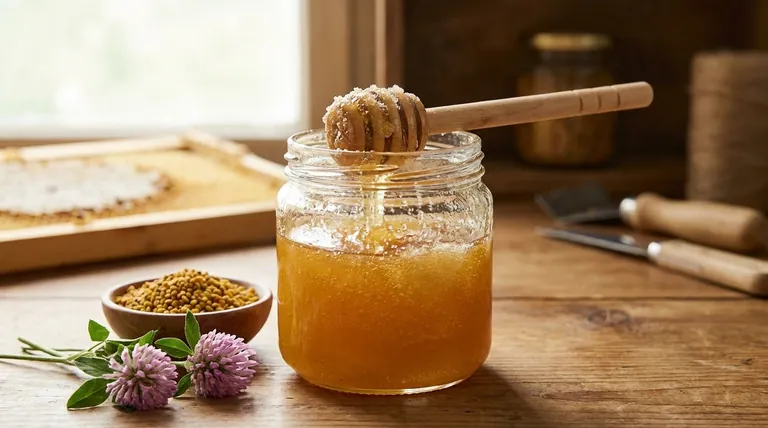In short, honey crystallizes because it's a natural, supersaturated sugar solution. It contains more sugar—specifically glucose—than can remain dissolved in its water content over the long term. As the unstable glucose separates from the water, it forms tiny crystals, causing the honey to thicken and become solid.
Crystallization is not a sign of spoilage or poor quality. On the contrary, it is a hallmark of raw, natural honey and an indicator of its authenticity.

The Science of Honey Crystallization
To understand why your honey hardens, you need to look at its fundamental composition. Honey is a complex mixture, but its behavior is primarily governed by three components: fructose, glucose, and water.
The Role of Glucose and Fructose
Honey is made of roughly 70% sugars and less than 20% water. The two primary sugars are fructose and glucose.
Fructose remains dissolved in water quite easily. Glucose, however, is much less soluble. Crystallization occurs when glucose separates from the water, forming the solid crystals that give crystallized honey its granular texture.
The ratio of glucose to fructose is the single most important factor determining how quickly honey will crystallize.
Why Floral Source Matters
The glucose-to-fructose ratio is determined by the nectar collected by the bees. Honey made from certain floral sources is naturally higher in glucose and will crystallize very quickly.
Common high-glucose honeys include those from clover, rapeseed (canola), ivy, and goldenrod. These can begin to crystallize within weeks of harvest.
Temperature as a Catalyst
Temperature plays a critical role in the speed of crystallization. The process is most rapid between 10°C and 18°C (50°F and 65°F).
Storing honey in a cool pantry or refrigerator will significantly accelerate crystallization. Conversely, warmer temperatures (above 25°C / 77°F) will keep it liquid for longer.
The Impact of "Seed" Particles
Crystallization needs a starting point, or a "seed," for the glucose crystals to build upon. In raw, unfiltered honey, these seeds are abundant.
Tiny particles of pollen, beeswax, and propolis act as nucleation sites, giving the glucose crystals a surface to cling to. This is why raw, minimally processed honey often crystallizes faster than highly filtered commercial honey.
Understanding the Trade-offs
The tendency of honey to crystallize creates a divide between natural honey and its processed commercial counterparts. Understanding this helps you know what you are buying and consuming.
Raw Honey vs. Processed Honey
Commercial honey producers often want to prevent crystallization to ensure a long shelf life of perfectly liquid, clear honey that is visually appealing to consumers.
To achieve this, they use two main techniques:
- Ultra-filtration: This process removes all pollen and other microscopic particles, eliminating the seed crystals.
- Pasteurization: Heating honey to high temperatures dissolves any existing sugar crystals and can slow the formation of new ones.
The downside is that these processes can also destroy the beneficial enzymes and delicate volatile compounds that give raw honey its unique flavor and aroma profile.
The Beekeeper's Challenge
For beekeepers, especially those using advanced systems like the Flow Hive, crystallization can be a practical challenge. If honey crystallizes in the comb, it can make harvesting difficult.
However, certain hive designs help manage this. The Flow Hive, for example, helps retain heat from the bee cluster, which can slow crystallization in the frames. It also allows for easy sampling so beekeepers can harvest high-glucose honey quickly before it sets.
How to Reliquefy Crystallized Honey
If your honey has crystallized, it is simple to return it to a liquid state. The key is to use gentle, controlled heat.
Place your honey jar in a warm water bath (around 40°C / 104°F) and stir occasionally until the crystals dissolve. Avoid using a microwave or boiling water, as excessive heat will degrade the quality and flavor of the honey.
Making the Right Choice for Your Goal
Ultimately, whether you see crystallization as a benefit or an inconvenience depends on your priorities.
- If your primary focus is a long-lasting liquid state: Store your honey at a stable room temperature and consider purchasing honey from floral sources known to be low in glucose, such as acacia or tupelo.
- If your primary focus is maximum natural quality: Embrace crystallization as a positive sign. You can enjoy the granular texture or gently warm it as needed.
- If your primary focus is beekeeping: Pay close attention to the floral sources your bees are visiting and be prepared to harvest high-glucose honey promptly to avoid it setting in the comb.
Understanding this natural process empowers you to fully appreciate the characteristics of pure, unadulterated honey.
Summary Table:
| Factor | Effect on Crystallization |
|---|---|
| High Glucose Content | Accelerates crystallization |
| Cool Temperatures (10-18°C) | Speeds up the process |
| Pollen/Particles in Raw Honey | Provides nucleation sites |
| Floral Source (e.g., Clover) | Higher glucose = faster crystallization |
For commercial apiaries and beekeeping equipment distributors: Ensure optimal honey quality and efficient harvesting with HONESTBEE's professional beekeeping supplies. Our Flow Hive systems and temperature management equipment help you maintain perfect honey consistency for your operations. Contact our wholesale team today to discuss your specific needs and bulk pricing.
Visual Guide

Related Products
- Natural Wood Honey Dipper for Tea Coffee and Desserts
- HONESTBEE 3-Frame Manual Acrylic Honey Extractor
- 2 Frame Stainless Steel Manual Honey Spinner Extractor for Beekeeping
- 10L Stainless Steel Electric Honey Press Machine
- Plastic Hand Crank 2 Frame Honey Extractor Low Price
People Also Ask
- Does honey draw out moisture? The Science of Honey's Hygroscopic Nature
- What is a honey taking spoon called? Discover the Tool for a Perfect, Mess-Free Drizzle
- What factors influence the water content of honey? Master Moisture Control for Stable Honey
- What can make honey runny? The Science of Sugar, Water, and Temperature
- How do you clean and store a honey dipper? Simple Steps for Long-Lasting Performance



















